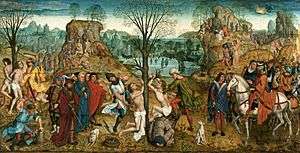Crispin and Crispinian
| Saints Crispin and Crispinian | |
|---|---|
|
The Martyrdom of SS. Crispin and Crispinian by Aert van den Bossche (National Museum, Warsaw). | |
| Martyrs | |
| Born | 3rd century AD |
| Died |
286 Rome |
| Venerated in |
Roman Catholic Church Eastern Orthodox Churches Church of England |
| Canonized | Pre-Congregation |
| Major shrine | Soissons |
| Feast | October 25 |
| Attributes | depicted holding shoes |
| Patronage |
cobblers; curriers; glove makers; lace makers; lace workers; leather workers; saddle makers; saddlers; shoemakers; tanners; weavers. San Crispin, San Pablo City, Philippines |
Saints Crispin and Crispinian are the Christian patron saints of cobblers, curriers, tanners, and leather workers. Beheaded during the reign of Diocletian; the date of their execution is given as 25 October 285 or 286.
History
Born to a noble Roman family in the 3rd century AD, Saints Crispin and Crispinian fled persecution for their faith, ending up at Soissons, where they preached Christianity to the Gauls whilst making shoes by night. While it is stated that they were twin brothers, that has not been positively proved.[1]
They earned enough by their trade to support themselves and also to aid the poor. Their success attracted the ire of Rictus Varus, governor of Belgic Gaul, who had them tortured and thrown into the river with millstones around their necks. Though they survived, they were beheaded by the Emperor c. 286.
An alternative account gives them to be sons of a noble Romano-Briton family who lived in Canterbury, following their father's murder for displeasing the Roman Emperor. As they were approaching maturity their mother sent them to London to seek apprenticeship and to avoid coming to the attention of their father's killer. Travelling there, the brothers came across a shoemaker's workshop at Faversham and decided to travel no further and stayed in Faversham. This account fails to explain how the brothers came to be venerated and martyred.
Veneration
The feast day of Saints Crispin and Crispinian is 25 October. Although this feast was removed from the Roman Catholic Church's universal liturgical calendar following the Second Vatican Council, the two saints are still commemorated on that day in the most recent edition of the Roman Church's martyrology.
In the sixth century a stately basilica was erected at Soissons over the graves of these saints, and St. Eligius, a famous goldsmith, made a costly shrine for the head of St. Crispinian.[1]
Popular culture
Saint Crispin is often associated with the Battle of Agincourt since the battle was fought on his feastday. It has been immortalised by Shakespeare's St. Crispin's Day Speech from his play Henry V. Also, for the Midsummer's Day Festival in the third act of Die Meistersinger, Wagner has the shoemakers' guild enter singing a song of praise to St. Crispin.
A plaque at Faversham commemorates their association with the town. They are also commemorated in the name of the old pub "Crispin and Crispianus" at Strood.
See also
- St Crispin Street Fair
- St. Crispin's Day Speech
- Daughters of St. Crispin
- Order of the Knights of St. Crispin
- City livery companies
Footnotes
| Wikimedia Commons has media related to Crispin and Crispinian. |
